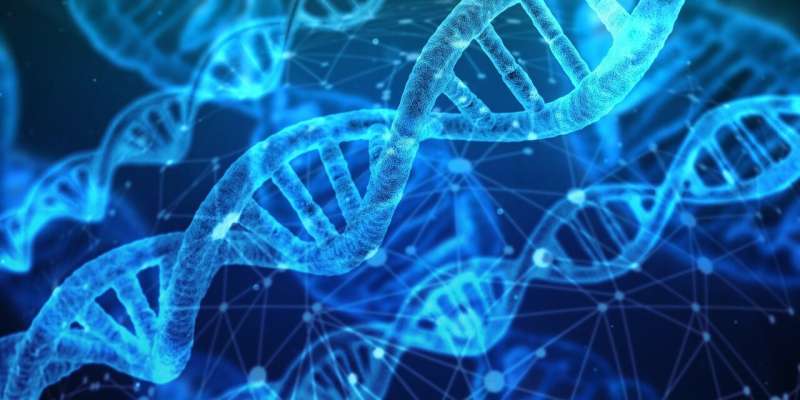Credit: Pixabay/CC0 Public Domain
The lack of certain genes in the BEC/TCEAL cluster could be related to alterations associated with autism spectrum disorder, according to a preclinical study published in the journal Genome Biology and led by Professor Jordi Garcia Fernàndez, from the Faculty of Biology and the Institute of Biomedicine of the University of Barcelona (IBUB), and researcher Jaime Carvajal, from the Andalusian Center for Developmental Biology—University Pablo de Olavide (CSIC-UPO).
The study analyzed transposon-derived genes that are involved in neural complex functions and that have not been studied before within the context of autism spectrum disorder and other neurological conditions. The study, carried out with animal models, describes some molecular mechanisms that are decisive in the development of the neocortex in humans and other placental mammals.
Transposon domestication: how can new functional genes originate?
The BEX/TCEAL cluster is a 14-gene genic family that is not well understood, located in the chromosome X. This genic family codes small proteins from the hub proteinas that connect with many other proteins, changing their configuration according to the local molecular context.
The researchers found that the genic group BEX/TCEAL resulted from a process known as transposon molecular domestication, by which genetic mobile elements can be placed in different areas of the genome. Through this process, a non-functional transposon gene can become a new active element of the genome (domesticated transposon), which develops similarly to the other genes.
Transposons are regarded as a source of evolutionary innovation and adaptation in human beings. "These are genetic components that have no function or are harmful to the host genome. However, in the case of the BEX/TCEAL cluster, they were domesticated by the molecular machinery of the ancestor of placental mammals. That is, they became new genes," says Professor Jordi García-Fernández, director of the Department of Genetics, Microbiology and Statistics of the UB and head of the Research Group on Evolution and Development (Evo-Devo).
During the evolutionary process, transposons can lose their ability to jump "due to new mutations, which join the neighboring effects of the regulator regions where they are, and transform these mobile elements into new genes that have not appeared before during the evolution," says researcher Enrique Navas-Pérez (UB-IBUB), first author of the article.
According to researcher Jaime J. Carvajal, vice-rector of CABD and head of the Research Group on Molecular Embryology, "such events can have a great importance when setting unique characteristics of mammals. We are looking at the function of a series of genes that could have contributed to the establishment of specific brain properties of placental mammals."
Genes related to autism spectrum disorder
The study states that the BEX3 gene, an element in the BEX/TCEAL cluster, plays a decisive role in the m-TOR path, a metabolic path related to proliferation and differentiation in many tissues, and especially those in the nervous system. In other studies, other genes from the cluster have been related to neurotrophins (molecules that regulate the neural proliferation in the embryonal nervous system) and p75, a receptor involved in neuronal death.
The conclusions show that the BEX3 gene, and most likely other elements in the BEX/TCEA complex, could be implied in several aspects of autism spectrum disorder and other neurological affectations. Therefore, the mice that were affected by the lack of one of these genes showed alterations in behavior related to autism spectrum disorder, apart from showing some anatomical and skeletal changes. "Mice without the BEX3 gene are antisocial and do not interact with other mice," notes researcher Ángel Carrión, from the Department of Neurosciences of UPO.
"These are new genes, derived from transposons, which are involved in complex neural functions and which have not been studied until now within the context of autism spectrum disorder and other neurological pathologies," note the researchers.
"Despite being young in evolutionary terms, they could integrate in established biological paths, becoming essential for the right functioning of the animal," notes Cristina Vicente-García, co-author of the article together with Enrique Navas-Pérez and Serena Mirra.
The authors report that the level of expression of these genes in individuals with autism spectrum disorder is low. As a result, the researchers observed a wide range of manifestations in laboratory models, in particular, from autism to compulsive behaviors.
Only a few genes in placental mammals are known—and specifically, no gene clusters—that derive from molecular domestication of transposons. For instance, those associated with RAG1/2 proteins, which are key elements of the adaptive immune system of vertebrates, or syncytines, which enabled the development of the complex placenta. "We think domestication of these transposons was an important process in the development of the neocortex in the group of placental mammals, to which we belong. Therefore, the effect that generated the BEX/TCEAL cluster on the ancestral genome conditioned the development of the brain of placental mammals," note the researchers.
"There are still 14 new genes to study that have not been studied until now, which could be involved in the formation of the complex brain and several manifestations of autism spectrum disorder. Also, the relation virus-transposons-immune system is very intriguing. For instance, the composition of transposon families of the bat genome is exceptional among mammals, and bats are immune to many viral infections," says Jordi Garcia-Fernández.
More information: Enrique Navas-Pérez et al. Characterization of an eutherian gene cluster generated after transposon domestication identifies Bex3 as relevant for advanced neurological functions, Genome Biology (2020). DOI: 10.1186/s13059-020-02172-3
Journal information: Genome Biology
Provided by University of Barcelona
























